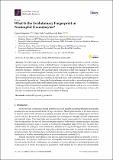| dc.contributor.author | Dolz, Gaby | |
| dc.contributor.author | Fingerhut, Leonie | |
| dc.contributor.author | de Buhr, Nicole | |
| dc.date.accessioned | 2020-07-24T21:28:27Z | |
| dc.date.available | 2020-07-24T21:28:27Z | |
| dc.date.issued | 2020-06-25 | |
| dc.identifier.uri | http://hdl.handle.net/11056/17731 | |
| dc.description.abstract | Over the years of evolution, thousands of di erent animal species have evolved. All these
species require an immune system to defend themselves against invading pathogens. Nevertheless,
the immune systems of di erent species are obviously counteracting against the same pathogen with
di erent e ciency. Therefore, the question arises if the process that was leading to the clades of
vertebrates in the animal kingdom—namely mammals, birds, amphibians, reptiles, and fish—was
also leading to di erent functions of immune cells. One cell type of the innate immune system
that is transmigrating as first line of defense in infected tissue and counteracts against pathogens is
the neutrophil granulocyte. During the host–pathogen interaction they can undergo phagocytosis,
apoptosis, degranulation, and form neutrophil extracellular traps (NETs). In this review, wesummarize
a wide spectrum of information about neutrophils in humans and animals, with a focus on vertebrates.
Special attention is kept on the development, morphology, composition, and functions of these cells,
but also on dysfunctions and options for cell culture or storage. | es_ES |
| dc.description.abstract | A lo largo de los años de evolución, miles de especies animales existentes han evolucionado. Todas estas especies requieren un sistema inmunológico para defenderse de los patógenos invasores. Sin embargo, los sistemas inmunes de las especies existentes están obviamente contrarrestando el mismo patógeno con la ciencia moderna. Por lo tanto, se plantea la cuestión de si el proceso que estaba conduciendo a los clados de vertebrados en el reino animal -es decir, mamíferos, aves, anfibios, reptiles y peces- también estaba conduciendo a funciones deficientes de las células inmunitarias. Un tipo de célula del sistema inmunológico innato que se transmigra como primera línea de defensa en el tejido infectado y contrarresta los patógenos es el granulocito de neutrófilo. Durante la interacción huésped-patógeno pueden sufrir fagocitosis, apoptosis, degranulación y formar trampas extracelulares de neutrófilos (NETs). En esta revisión, resumimos un amplio espectro de información sobre los neutrófilos en humanos y animales, centrándonos en los vertebrados. Se presta especial atención al desarrollo, la morfología, la composición y las funciones de estas células, pero también a las disfunciones y las opciones de cultivo o almacenamiento celular. | es_ES |
| dc.language.iso | eng | es_ES |
| dc.publisher | University of Veterinary Medicine Hannover, Hannover, Germany | es_ES |
| dc.rights | Acceso abierto | es_ES |
| dc.rights.uri | http://creativecommons.org/publicdomain/zero/1.0/ | * |
| dc.source | Int. J. Mol. Sci. vol. 21, 4523 (2020) | |
| dc.subject | INMUNOLOGÍA | es_ES |
| dc.subject | NEUTROPHILS | es_ES |
| dc.subject | SPECIES | es_ES |
| dc.subject | GRANULOCYTES | es_ES |
| dc.subject | ANIMALES | es_ES |
| dc.subject | SERES HUMANOS | es_ES |
| dc.title | What Is the Evolutionary Fingerprint in Neutrophil Granulocytes? | es_ES |
| dc.type | http://purl.org/coar/resource_type/c_6501 | es_ES |
| dc.description.procedence | Escuela de Medicina Veterinaria | es_ES |
| dc.identifier.doi | doi:10.3390/ijms21124523 | |


